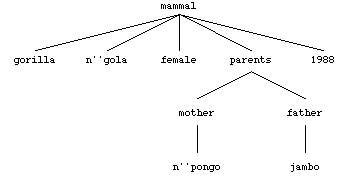|
Structured objects can be drawn as trees. Each non-terminal node
(that is, a node with a branch growing from it) is a functor of
a structured object; each terminal node (sometimes known as "leaves"
or "leaf nodes") is a term that is atomic or a variable.
We'll start with a simple example:
parents('n''pongo', jambo).

Examples with a structured object within a structured object produce
more interesting trees. Take, for example:
parents(mother('n''pongo'), father(jambo)).

Finally, we'll have an example using the most extensive case presented
above:
mammal(gorilla, 'n''gola', female, parents(mother('n''pongo'),
father(jambo)), 1988).

We can see from this example that structured objects can have any
number of arguments and don't have to be balanced or symmetrical.
|